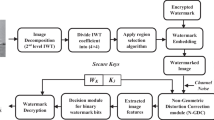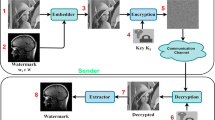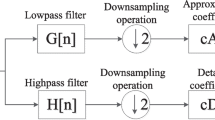Abstract
Copyright notification and enforcement, authentication, covert communication, and hybrid transmission applications such as digital audio broadcasting are examples of emerging multimedia applications for digital watermarking and information embedding methods, methods for embedding one signal (e.g., the digital watermark) within another “host” signal to form a third, “composite” signal. The embedding is designed to achieve efficient trade-offs among the three conflicting goals of maximizing information-embedding rate, minimizing distortion between the host signal and composite signal, and maximizing the robustness of the embedding.
We present a class of embedding methods called quantization index modulation (QIM) that achieve provably good rate-distortion-robustness performance. These methods, and low-complexity realizations of them called dither modulation, are provably better than both previously proposed linear methods of spread spectrum and nonlinear methods of low-bit(s) modulation against square-error distortion-constrained intentional attacks. We also derive information-embedding capacities for the case of a colored Gaussian host signal and additive colored Gaussian noise attacks. These results imply an information embedding capacity of about 1/3 b/s of embedded digital rate for every Hertz of host signal bandwidth and every dB drop in received host signal quality.
We show that QIM methods achieve performance within 1.6 dB of capacity, and we introduce a form of postprocessing we refer to as distortion compensation that, when combined with QIM, allows capacity to be achieved. In addition, we show that distortion-compensated QIM is an optimal embedding strategy against some important classes of intentional attacks as well. Finally, we report simulation results that demonstrate the performance of dither modulation realizations that can be implemented with only a few adders and scalar quantizers.
Similar content being viewed by others
References
F. Hartung and M. Kutter, “Multimedia Watermarking Tech-niques, ” Proceedings of the IEEE, vol. 87, 1999, pp. 1079–1107.
M.D. Swanson, M. Kobayashi, and A.H. Tewfik, “Multimedia Data-Embedding and Water-Marking Technologies, ” Proceed-ings of the IEEE, vol. 86, 1998, pp. 1064–1087.
I.J. Cox and J.-P.M.G. Linnartz, “Some General Methods for Tampering with Watermarks, ” IEEE Journal on Selected Areas in Communications, vol. 16, 1998, pp. 587–593.
J.-P. Linnartz, T. Kalker, and J. Haitsma, “Detecting Electronic Watermarks in Digital Video, ” in Proc.of the 1999 IEEE Interna-tional Conference on Acoustics, Speech, and Signal Processing, Phoenix, AZ, March 1999, vol. 4, pp. 2071–2074.
D. Kundur and D. Hatzinakos, “Digital Watermarking for Tell-tale Tamper Proofing and Authentication, ” Proceedings of the IEEE, vol. 87, 1999, pp. 1167–1180.
F.A.P. Petitcolas, R.J. Anderson, and M.G. Kuhn, “Information Hiding-A Survey, ” Proceedings of the IEEE, vol. 87, 1999, pp. 1062–1078.
B. Chen, “Design and Analysis of Digital Watermarking, Infor-mation Embedding, and Data Hiding Systems, ” Ph.D. Thesis, Massachusetts Institute of Technology, Cambridge, MA, June 2000.
H.C. Papadopoulos and C.-E.W. Sundberg, “Simultaneous Broadcasting of Analog FMand Digital Audio Signals by Means of Adaptive Precanceling Techniques, ” IEEE Transactions on Communications, vol. 46, 1998, pp. 1233–1242.
B. Chen and C.-E.W. Sundberg, “Broadcasting Data in the FM Band by Means of Adaptive Contiguous Band Insertion and Precancelling Techniques, ” in Proceedings of 1999 IEEE Inter-national Conference on Communications, Vancouver, Canada, June 1999, vol. 2, pp. 823–827.
M.D. Swanson, B. Zhu, and A.H. Tewfik, “Data Hiding for Video-in-Video, ” in Proceedings of the 1997 IEEE International Conference on Image Processing, Piscataway, NJ, 1997, vol. 2, pp. 676–679.
B. Chen and G.W. Wornell, “Quantization Index Modulation: A Class of Provably Good Methods for Digital Watermarking and Information Embedding, ” To appear, IEEE Transactions on Information Theory, accepted for publication.
W. Bender, D. Gruhl, N. Morimoto, and A. Lu, “Techniques for Data Hiding, ” IBM Systems Journal, vol. 35, no. 3/4, 1996, pp. 313–336.
I.J. Cox, J. Killian, T. Leighton, and T. Shamoon, “A Secure, Robust Watermark for Multimedia, ” in Information Hiding.First International Workshop Proceedings, June 1996, pp. 185–206.
J.R. Smith and B.O Comiskey, “Modulation and Information Hiding in Images, ” in Information Hiding.First International Workshop Proceedings, June 1996, pp. 207–226.
J.R. Hernandez, F. Perez-Gonzalez, J.M. Rodriguez, and G. Nieto, “Performance Analysis of a 2-D-Multipulse Amplitude Modulation Scheme for Data Hiding and Watermarking of Still Images, ” IEEE Journal on Selected Areas in Communications, vol. 16, 1998, pp. 510–524.
A.Z. Tirkel, G.A. Rankin, R. van Schyndel, W.J. Ho, N.R.A. Mee, and C.F. Osborne, “Electronic Water Mark, ” in Proceed-ings of Digital Image Computing, Technology and Applications, Sydney, Australia, Dec. 1993, pp. 666–672.
R. van Schyndel, A.Z. Tirkel, and C.F. Osborne, “A Digital Wa-termark, ” in Proceedings of the First IEEE International Con-ference on Image Processing, Austin, TX, Nov. 1994, vol. 2, pp. 86–90.
I.J. Cox, J. Killian, F.T. Leighton, and T. Shamoon, “Secure Spread Spectrum Watermarking for Multimedia, ” IEEE Trans-actions on Image Processing, vol. 6, pp. 1673–1687, 1997.
J.K. Su, “Power-Spectrum Condition-Complaint Watermarking, ” DFG V 3 D 2 Watermarking Workshop, Oct. 1999. Abstract and transparencies from this talk were obtained from http://www.lnt.de/~watermarking.
C.I. Podilchuk and W. Zeng, “Image-Adaptive Watermarking Using Visual Models, ” IEEE Journal on Selected Areas in Com-munications, vol. 16, 1998, pp. 525–539.
M.D. Swanson, B. Zhu, and A.H. Tewfik, “Robust Data Hiding for Images, ” in Proceedings of the 1996 IEEE Digital Signal Processing Workshop, Loen, Norway, Sept. 1996, pp. 37–40.
B. Chen and G.W. Wornell, “Dither Modulation: A New Ap-proach to Digital Watermarking and Information Embedding, ” in Proceedings of SPIE: Security and Watermarking of Multime-dia Contents, San Jose, CA, Jan. 1999, vol. 3657, pp. 342–353.
J. Wolosewicz and K. Jemili, “Apparatus and Method for En-coding and Decoding Information in Analog Signals, ” United States Patent #5,828,325, Oct. 1998.
E.A. Lee and D.G. Messerschmitt, Digital Communication, 2nd edn., Boston, MA: Kluwer Academic Publishers, 1994.Quantization Index Modulation Methods 33
N.S. Jayant and P. Noll, Digital Coding of Waveforms: Princi-ples and Applications to Speech and Video, Englewood Cliffs, NJ: Prentice-Hall, 1984.
R. Zamir and M. Feder, “On Lattice Quantization Noise, ” IEEE Transactions on Information Theory, vol. 42, 1996, pp. 1152–1159.
G. Ungerboeck, “Channel Coding With Multilevel/Phase Sig-nals, ” IEEE Transactions on Information Theory, vol. 28, 1982, pp. 55–67.
T.M. Cover, “Broadcast Channels, ” IEEE Transactions on In-formation Theory, vol. 18, 1972, pp. 2–14.
K. Ramchandran, A. Ortega, K.M. Uz, and M. Vetterli, “Multiresolution Broadcast for Digital HDTV Using Joint Source/Channel Coding, ” IEEE Journal on Selected Areas in Communications, vol. 11, 1993, pp. 6–23.
T.M. Cover and J.A. Thomas, Elements of Information Theory, New York, NY: John Wiley & Sons, 1991.
M.H.M. Costa, “Writing on Dirty Paper, ” IEEE Transactions on Information Theory, vol. IT-29, 1983, pp. 439–441.
P. Moulin and J.A. O'Sullivan, “Information-theoretic analysis of information hiding, ” Preprint, 1999.
S.I. Gel'fand and M.S. Pinsker, “Coding for Channel with Ran-dom Parameters, ” Problems of Control and Information Theory, vol. 9, no. 1, 1980, pp. 19–31.
A.S. Willsky, G.W. Wornell, and J.H. Shapiro, “Stochastic Pro-cesses, Detection and Estimation, ” MIT 6.432 Supplementary Course Notes, Cambridge, MA, 1996.
S. Lin and D.J. Costello,Jr., Error Control Coding: Funda-mentals and Applications, Englewood Cliffs, NJ: Prentice-Hall, 1983.
R.J. Barron, B. Chen, and G.W. Wornell, “The Duality Between Information Embedding and Source Coding with Side Informa-tion and Its Implications and Applications, ” IEEE Transactions on Information Theory, submitted.
B. Chen and G.W. Wornell, “Provably Robust Digital Water-marking, ” in Proceedings of SPIE: Multimedia Systems and Ap-plications II, Boston, MA, Sept. 1999, vol. 3845, pp. 43–54.
Author information
Authors and Affiliations
Rights and permissions
About this article
Cite this article
Chen, B., Wornell, G.W. Quantization Index Modulation Methods for Digital Watermarking and Information Embedding of Multimedia. The Journal of VLSI Signal Processing-Systems for Signal, Image, and Video Technology 27, 7–33 (2001). https://doi.org/10.1023/A:1008107127819
Published:
Issue Date:
DOI: https://doi.org/10.1023/A:1008107127819




